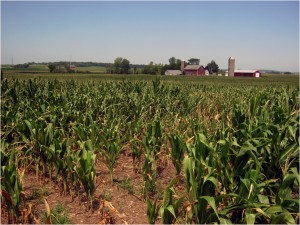1 September 2015
High water tables can be a boon to crop yields
Posted by Nanci Bompey
By Jenny Seifert

Shallow groundwater can provide much-needed water during droughts, such as the one that hit Wisconsin in 2012.
Credit: Samuel Zipper
High water tables can be a bane to crop yields, compelling many farmers to drain their fields so their crops don’t drown when it rains.
But a high water table may not always be a bad thing. A new study shows it is actually a boon for some fields and during certain times of the growing season, casting light on opportunities for improving yield efficiency to meet global food demands.
The researchers found high water tables can provide much-needed water during drought and to crops planted in coarse-grained soils, which have a harder time retaining water than their fine-grained counterparts, like silt loam.
“Every soil type has a sweet spot in terms of the optimum water table depth for the highest crop yield,” explains Samuel Zipper, a graduate student in the Freshwater and Marine Sciences Program in the College of Engineering at the University of Wisconsin – Madison, and lead author of the new study published online in Water Resources Research, a journal of the American Geophysical Union. Zipper said the study is the first to look at the interactions between water table depth, soil texture and weather.
Timing, too, is everything.
While rains early in the growing season can waterlog fields, a high water table becomes an advantage later in the season, when the weather is drier and crops need the extra water to pollinate and produce grain.
In fact, Zipper found the benefits of a high water table, also called shallow groundwater, often outweighed the costs for crops in the coarse-grained soils and even many of the fine-grained soils in their study site, rendering higher crop yields, or “groundwater yield subsidies.”
“Surprisingly, even in a wet year, the net benefits of shallow groundwater outweighed the losses,” says Zipper.
A significant roadblock to efficiently feeding the world’s growing population is the “yield gap,” when crop yields don’t meet their full potential. Stress from either too much water or not enough is one of the factors that can lead to shortfalls.
Zipper says a better understanding of how groundwater depth, soil texture and the weather interact to affect crop yields can help farmers determine optimal field-draining depths that will help yields reach their full potential.
By comparing fields’ yield performance in wet and dry years and connecting results to water table depth and soil texture, co-author Steven Loheide, an associate professor of civil and environmental engineering at the University of Wisconsin-Madison, explains they were able to map more precisely where fields are sensitive to drought or waterlogging and why, a technique with implications for precision agriculture.
“Our data showed that small patches of the field, separated by just tens of meters, have strikingly different sensitivities to drought due to variations in groundwater depth and soil texture,” says Loheide.
Such knowledge could help farmers better invest their resources and target areas that should perform well, especially as extreme weather becomes more common.
“In the long term, farmers should be able to look at the general forecast for a season, decide what to plant where and control groundwater levels to meet crop needs,” says Zipper.
— Jenny Seifert is the science writer/outreach coordinator for the Water Sustainability and Climate(WSC) project at the University of Wisconsin-Madison. This post originally appeared as a press release on their website.










 GeoSpace is a blog on Earth and space science, managed by AGU’s Public Information staff. The blog features posts by AGU writers and guest contributors on all sorts of relevant science topics, but with a focus on new research and geo and space sciences-related stories that are currently in the news.
GeoSpace is a blog on Earth and space science, managed by AGU’s Public Information staff. The blog features posts by AGU writers and guest contributors on all sorts of relevant science topics, but with a focus on new research and geo and space sciences-related stories that are currently in the news.